Aug 20, 2013
Search Engine Optimization (SEO) is an ever changing field where algorithm updates take place rapidly. That’s why optimizing a website requires endless research and analysis in order to survive whatever search engines bring to the table.
Today, optimizing a website requires the ability to adapt to the nature of every business to deliver the desired or targeted results in terms of online marketing. Every business has its own “peak season” where the number of customers doubles, compared to the “off” seasons. That’s where market seasonality research comes in.
In online marketing, there are ways to mine and analyze data to determine if it is the right time to approach customers or not. Here are some of the most effective ways of analyzing the market’s most profitable season while doing keyword research:
Business nature analysis – As mentioned, this is one of the most vital parts in optimizing a website. This is where the road map begins, and it serves as a live skeleton for every online marketing campaign.
Learn how the business is run, what kind of customers can afford their products/services, business location and other possible places to market their products/services, how their products/services work, and their benefits.
Come up with a list of possible keywords – After analyzing the business nature, come up with a list of keywords that will be used in marketing campaigns. This doesn’t require keyword tools. Just list relevant words and phrases.
Tip: To come up with a comprehensive list, start with one-word keywords and then play with prefixes and suffixes to make phrases.
e.g.: Gift > Christmas Gift > Gift Wrapper > Valentines Gift > Affordable Gift Wrapper
To add more variation, use Latent Semantic Indexing. Use correlated words to vary up your key phrases/keywords. For example, instead of focusing on the keyword “gift”, use its correlated words like present, offering, endowment, etc.
Google Keyword Planner – Google recently removed its traditional keyword tool and replaced it with a keyword planner (it still redirects to the old one sometimes). Though this tool is intended for adwords, it can be used to analyze market trends for SEO/online marketing purposes as well. This is where keyword filtering and prioritization is important.
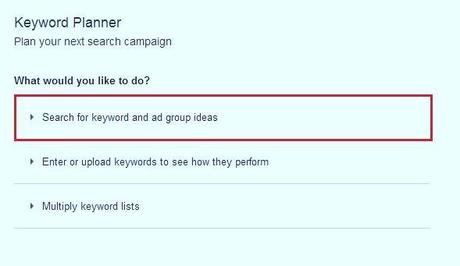
To start, go to Google Keyword Planner Tool and log in to your account. You can choose to look at the performance of the keywords, or search for ad group ideas. To get the best possible ideas, choose the first option then dig deeper for more variations:
Enter your preferred ideas in the box. There is no need to customize your search as you are only getting possible keyword ideas that you can target. Click “Get ideas”.
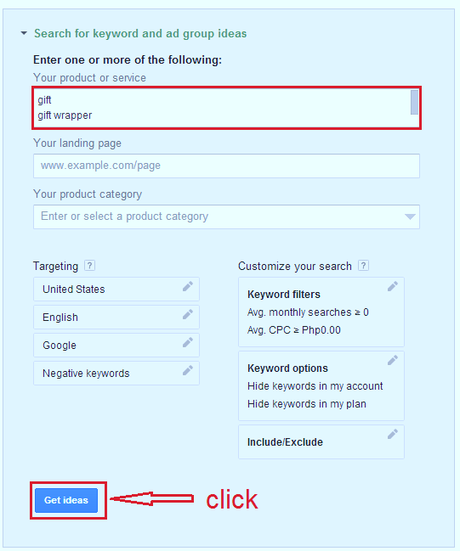
You will get a bunch of ad and keyword ideas. The first set of keywords is the most relevant to the ones you put in the previous menu. The other ideas can be added to your list, and be used in your online marketing campaign. Remember, select the most relevant keywords.
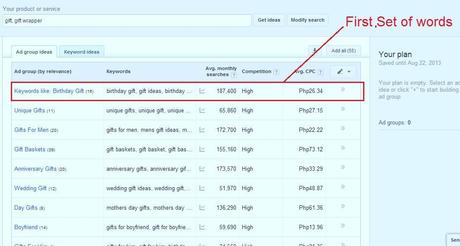
Make another list of your preferred keywords, or to make it more comprehensive, get all words that are related to “Gift”.
After making the list, it’s now time to filter them for keyword prioritization. Enter the list of ideas in the box. This time, use “Enter or upload keywords to see how they perform” and click “Get search volume”.

We want the keywords to be prioritized based on the number of searches, competitiveness and search volume per month. We can also check the CPC rate of a certain keyword to see how profitable they are. Remember that high CPC rates can be profitable, but chances are high that those keywords are already dominated by PPC campaigns, making the organic search list unnoticeable by most users.
You should now see the keywords and their approximate search data. Download the data by clicking the button on the upper right.
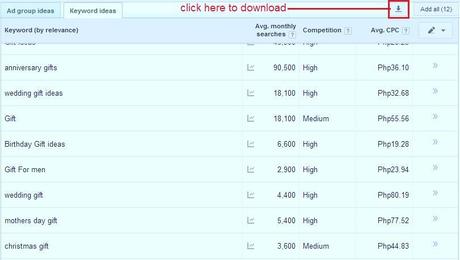
After downloading it, open the file. It will open in Excel. You will see approximate data on the keywords you chose, from average monthly searches and search volume per month, to competition and average CPC.

To get the most profitable keywords from your list, you can add all the searches from the month of September 2012 up to August 2013, and divide the total by 12 (one year). The result will be your final approximate search volume. Arrange them from highest to lowest search, and the keywords with high total volume will be the prospects in your campaign (I only show 12 examples here, but you can use as many keywords as you like).
Use Google Trends – After getting the prospective keywords, you can check how often they are searched using Google Trends. Though it sometimes provides different results, you will still have an idea of when it is the most profitable season to execute plans and strategies. It will also give you an idea on what specific month is the most profitable for a certain keyword based on its seasonality.
In addition, it is a good tool to predict the possible peak season for a certain service. This will allow you to prepare good marketing strategies ahead of time.
Mind mapping – This is where the main campaign road map begins. By definition, mind mapping is the process of outlining information and breaking them down based on the correlation and field of a certain topic.
In online marketing, mind mapping is another form of inbound marketing strategy that creates a domino-like idea on how to form a group of topics that will provide information to a specific group of queries. One of the best tools for mind mapping is the Text 2 Mind Map.
The idea behind using a mind mapping tool is to segregate information based on the relevancy of a certain topic to its field and theme. This will help you to identify targeted leads based on the profitability season.
Refer to the image below on how the tool works:
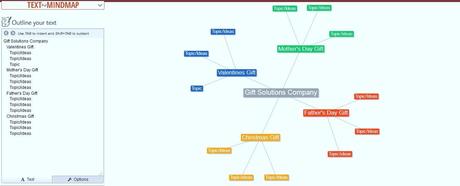
Note: Play with the tool to maximize its usefulness in planning an online marketing campaign. You can put in additional ideas like location, correlated words, etc.
Now that you have mapped your ideas, it is time to create content that surrounds those ideas. Remember to identify the kind of approach and direction of the content.
If the idea is to raise awareness about a product or service, create content that explains how the product or service works. If the direction is inbound, you want content that will use customer or user experience and reviews to lure possible leads and sales.
Create content that relates to trending industry topics – After listing and filtering the keywords, analyzing the trends, and mapping out the ideas and topics, you are now ready to create content. In order to benefit from the so-called “Market’s Peak Season”, it is essential to come up with topics that are relevant to that specific season.
Lead / link prospecting – This process can be simultaneously done while creating content. Lead or link prospecting is the process of getting relevant sources to land the finished content, or at least get a link back for traffic and conversion. It can be in the form of guest blogging, social media outreach, Interaction, etc.
All in all, the whole process from planning to execution takes a lot of time. That is why making a schedule ahead of time for every task is a must, to avoid delays and missed sales opportunities.
About the author:
Mario is a web marketing specialist for Maxweb Inc., an online marketing and web development firm in the Philippines.
